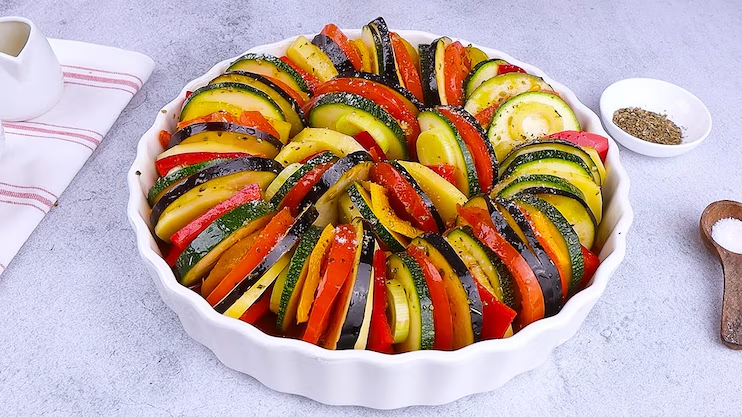sonakshisinha.net – Ratatouille, a quintessential dish from the south of France, embodies the heart and soul of Provençal cuisine. Known for its rich array of vegetables, aromatic herbs, and robust flavors, ratatouille is a perfect example of how simple, fresh ingredients can come together to create a dish that is both nourishing and delicious. Though its name is now globally recognized, ratatouille holds a special place in French culinary tradition, particularly in the region of Provence.
The Origins of Ratatouille
The origins of ratatouille date back to the 18th century in the Provence region. It is believed that the dish was created by farmers as a way to use up the summer harvest of vegetables. The name “ratatouille” comes from the French word “rata,” meaning a dish that is “stewed” or “mixed,” and “touiller,” which means to stir. The dish was originally a humble, rustic meal made from simple, locally grown vegetables like tomatoes, eggplant, zucchini, and bell peppers.
Over time, ratatouille evolved into a dish that would be enjoyed by families, chefs, and gourmets alike. While the basic components of the dish have remained consistent, variations of ratatouille exist across France, each region bringing its own nuances to the recipe.
The Key Ingredients of Ratatouille
Ratatouille is known for its use of fresh, seasonal vegetables, and the dish is often made in the height of summer, when vegetables like tomatoes, zucchini, and peppers are in abundance. The classic ingredients include:
- Eggplant: The soft, spongy texture of eggplant absorbs the flavors of the other ingredients and adds a savory depth to the dish.
- Zucchini: Its mild flavor and tender texture complement the other vegetables, providing a subtle sweetness.
- Bell peppers: Red, yellow, and green peppers bring color and a mild, slightly sweet flavor to the dish.
- Tomatoes: The base of the sauce, tomatoes add acidity and a rich, juicy element to the dish.
- Onions: They add sweetness and depth to the sauce, as well as a subtle savory flavor.
- Garlic: A key aromatic ingredient, garlic infuses the dish with its characteristic pungency and warmth.
- Herbs: Fresh basil, thyme, and rosemary are commonly used, along with bay leaves, to season the dish and impart its distinct Provençal fragrance.
Traditional Cooking Methods
The traditional method of making ratatouille involves cooking the vegetables separately to preserve their distinct textures and flavors before combining them into one dish. The vegetables are first sautéed individually to allow each one to caramelize slightly, which brings out their natural sweetness and richness. Afterward, they are combined in a large pot or pan, where they cook gently in their own juices, along with garlic, herbs, and a touch of olive oil, to form a savory, aromatic stew.
In some variations, the vegetables are sliced thinly and arranged in layers, creating a beautiful, colorful presentation. This method, known as “tian” (after the traditional Provençal baking dish), is popular for its visual appeal and more even cooking. The ratatouille is then baked in the oven to allow the flavors to meld and the vegetables to soften into a harmonious whole.
Ratatouille in French Culture
In France, ratatouille is more than just a side dish; it’s a symbol of Provence’s vibrant agricultural heritage. It represents the bounty of the land and the simplicity of French country cooking. Traditionally, ratatouille is enjoyed in the summer months, when the vegetables are at their peak, but it is also a versatile dish that can be served year-round, either hot or cold. It pairs well with crusty bread, rice, or couscous, and it is often served as a side dish alongside grilled meats, fish, or even as a main course with a dollop of goat cheese or a sprinkle of herbs.
Ratatouille is often seen at family gatherings, picnics, and local festivals, where it’s served in large batches to be shared among friends and loved ones. It’s a dish that celebrates the joy of communal eating and the connection between food, family, and tradition.
Modern Variations of Ratatouille
While the classic version of ratatouille remains popular, modern interpretations and adaptations of the dish have emerged in recent years. One of the most well-known contemporary renditions is the version featured in the 2007 animated film Ratatouille, where the dish is transformed into a visually stunning, artful composition. In this version, the vegetables are arranged in an intricate spiral pattern, creating a beautiful presentation that elevates the humble vegetable stew into a work of art.
Some chefs also experiment with adding other ingredients to ratatouille, such as olives, capers, or even a splash of vinegar, to enhance the dish’s flavor profile. Vegetarian and vegan variations are common, and the dish can easily be adapted to suit various dietary preferences.
Conclusion
Ratatouille is a dish that embodies the spirit of French home cooking: simple, rustic, and deeply flavorful. Whether served in its classic form or as a modern variation, ratatouille remains a timeless favorite for food lovers around the world. Its vibrant colors, fresh ingredients, and wholesome flavors make it a perfect example of the beauty and versatility of Mediterranean cuisine. Whether enjoyed in the sun-drenched hills of Provence or in the comfort of your own kitchen, ratatouille is a dish that celebrates the joy of eating well.
